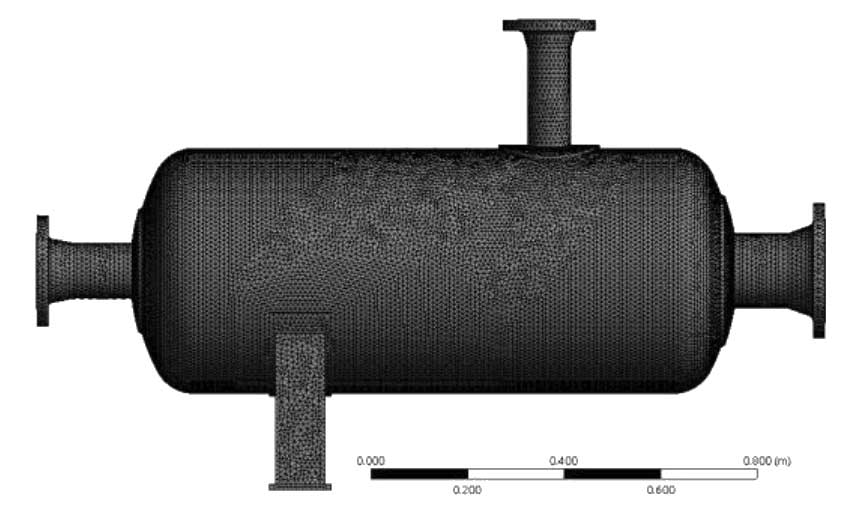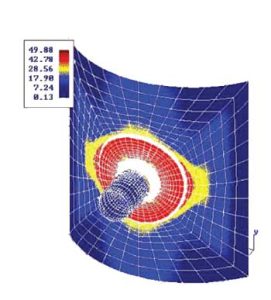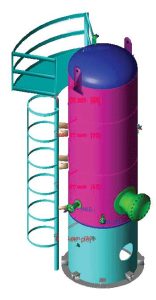Pressure Vessel
The term “Pressure vessel” is refers to a closed containers designed to store fluid at a pressure greater than 15 psi or 1 atm. This pressure can be imposed by the internal pressure caused by the fluid or the external pressure created by the direct or indirect heating of the vessel. Pressure gradient is a serious parameters in designing a pressure vessel. In fact, the more pressure difference in the pressure vessel, the more possibility of explosion and destruction.
The term “Pressure vessel” is refers to a closed containers designed to store fluid at a pressure greater than 15 psi or 1 atm. This pressure can be imposed by the internal pressure caused by the fluid or the external pressure created by the direct or indirect heating of the vessel. Pressure gradient is a serious parameters in designing a pressure vessel. In fact, the more pressure difference in the pressure vessel, the more possibility of explosion and destruction.
The term “Pressure vessel” is refers to a closed containers designed to store fluid at a pressure greater than 15 psi or 1 atm. This pressure can be imposed by the internal pressure caused by the fluid or the external pressure created by the direct or indirect heating of the vessel. Pressure gradient is a serious parameters in designing this product. In fact, the more pressure difference in this product, the more possibility of explosion and destruction. Considering the mentioned concerns, the design, construction and commissioning of these vessels are performed under legal supervision by official engineering associations. Maximum allowable pressure and temperature are two major parameters which distinguish the vessels from each other. HAVAYAR industrial group is one of the pioneering companies in employing universal standards for designing and manufacturing of pressure vessels. The mentioned procedure results in safety and operational assurance of this product.
Types of pressure vessels
Pressure vessels can be clustered from different points of view as follows:
- Layout: horizontal or vertical
- Type of stored fluid: gas or liquid
- Wall thickness: thin wall or thick wall
- Tank geometry: spherical, cylindrical or conical
Pressure vessels geometry
Pressure vessels may theoretically exist in any shape, but cylindrical vessels are the most common type which are designed and manufactured by HAVAYAR industrial group. These tanks are made of a cylinder with two caps at the front and the end which is a typical design in pressure vessel industry. The geometric shape of the two caps is often in the form of a convex lens of Elliptical 2:1 type or torispherical.
Application of pressure vessels
Pressure vessels are widely used in various industries. this product which are commonly manufactured in HAVAYAR have different applications which can be listed as: compressed air receivers, dryer towers, and nitrogen and oxygen generator adsorption towers. It should be noted that the mentioned this product is commonly employed in the oil, gas and petrochemical industries.
Design and construction of pressure vessels
These vessels can be designed and produced based on different standards, but the most referenced standard in our country is the ASME standard (ASME Boiler and Pressure Vessel Code), which is abbreviated BPVC for short.
The construction procedure of the mentioned vessels include rolling steel sheets by rolling machine and welding them to the pre-constructed heads. During the construction, welding procedure is very vital as the temperature rise in welding point can change the properties of the material and lead to an irreparable obstacles unless procedures to be prepared and considered before welding. These needs lead to the production of this product welding procedure so called called WPS, which is the abbreviation of Welding Procedure Specification. The tests performed on pressure vessels mainly include one or more of the following tests:
- Hydro-Static test
- Leak test
- Visual test (VT)
- Magnetic test (MT)
- Penetrant test (PT)
- Ultrasonic test (UT)
- Radio-graphic test (RT)
Applicable materials in pressure tanks
Theoretically, any material which has appropriate mechanical properties and is chemically stable in various applications can be employed in pressure vessels manufacturing.
The available codes and standards such as ASME section II, which contains list of materials with their temperature limits are employed for the design and selection of materials of these vessels. Most pressure vessels are made of steel. To produce a cylindrical or spherical tank, the rolled parts must be welded together.
Some of the physical properties of steel, resulting from rolling, can be affected by the welding process, unless special actions are taken to prevent these damages. Also, in order to achieve proper mechanical strength, existing standards recommend steel due to its high impact resistance at low temperatures. The ASME standard persuade the manufacturer to choose a material which has not only a proper mechanical strength but also has an adequate impact strength. It should be noted that for the corrosive environments or fluids, it is necessary to use materials with low corrosion allowance at the mentioned medium.
Common codes and standards for design of pressure vessels in HAVAYAR industrial group:
- ASME Section VIII-div.1 / VIII-div.2 (Construction of Pressure Vessels)
- ASME Section II – (Materials)
- ASME Section V – (Nondestructive Examination)
- ASME Section IX – (Qualification Standard for Welding …)
In the construction of this product, the mentioned codes and standards are usually employed. But it should be mentioned that handbooks of pressure tanks are also widely used for the design of this type of tanks.
Common software for design of pressure vessels in HAVAYAR industrial group:
- PV-Elite
- Nozzle Pro
- Ansys
- HTFS
- Auto-Cad
- Inventor



The method of designing fixed equipment
According to the needs, requirements and process specifications of the designed equipment, including parameters of operating pressure, operating temperature and fluid type, the design and construction standards of the equipment are determined.
The initial plan is simulated and analyzed in PV Elite software considering the input data. (At this stage, all the design specifications will be implemented according to the relevant standards, input specifications, and the agreements made with employer in the bidding stage.) Finally, after performing mechanical calculations and analysis by PV Elite software, general arrangement and assembly procedure is generated, which contains the required information for the vessel construction. This document contains general dimensional information, thicknesses, and required material.
The construction plan along with the relevant data sheet, calculations and BOM list with all the details of manufacturing along with the quality control documents such as painting, welding and related testing procedures will be presented to the client and upon their approval, the IFC version will be sent to the construction workshop.
As the vessel assembly finishes and employer’s third-party inspector approval receives, the equipment is packed according to the packing and shipment procedure which has already been approved by the employer, and after the inspector’s approval and release note, the equipment is delivered to the employer’s site.
The above mentioned design procedure is applicable for all employed pressure vessels. In the case of special design (high pressure or fatigue analysis requirements), in addition to analysis with PV Elite software, finite element analysis (FEA) calculations also should be done by specialized software like Ansys or Abaqus with respect to the limitations of ASME Sec.VIII Div.2.
It should be noted that during the construction period, installation and commissioning, technical feedbacks are passed on to design experts in order to prepare the final revision of technical documents so called as built revision.
Design and engineering
HAVAYAR industrial group, by using technical experts graduated from top rank universities of the country and with complete mastery and familiarity with the latest editions of international standards such as DIN, BS, IPS, ASME, TEMA, API, NACE, etc. and laying on many years of experience in design and optimization of various types of fixed equipment, including shell and tube heat exchangers, pressure vessels, etc., and also employing professional software related to design and simulation activities such as Aspen B-Jac, HTFS, HTRI, PV-Elite, HYSYS, Inventor, Auto cad, Nozzle pro, Ansys, etc. play an irreplaceable role in meeting the specialized needs of the country’s industry in the field of fixed equipment.
Among the duties of fixed equipment specialists in HAVAYAR, the following can be mentioned:
- Receiving MR (Material Requisition) for the fixed equipment packages and studying it first.
- Completing calculations and preparing preliminary plans
- Preparation of technical proposals and related documents according to MR
- responding to questions and ambiguities and clarification of the client.
- Participating in meetings to remove ambiguity and discuss technical deviations.
- Investigation of the technical parts of the contract and finalizing the Purchase Order (PO)
- Preparation of calculations, General arrangement and assembly drawing, welding and inspection documents and their methods such as PQR & WPS and technical specification sheets and obtaining their approval.
- Eliminating construction ambiguities and problems and supervising construction procedure and inspecting equipment.
- Supply & Scope of Work
- Preparation of confidential documents for tests and inspections
- Preparation and finalization of Final Vendor Data Book.
- Preparation of equipment delivery documents
Frequently Asked Questions
The term “Pressure vessel” is refers to a closed containers designed to store fluid at a pressure greater than 15 psi or 1 atm. This pressure can be imposed by the internal pressure caused by the fluid or the external pressure created by the direct or indirect heating of the vessel. Pressure gradient is a serious parameters in designing a pressure vessel. In fact, the more pressure difference in the pressure vessel, the more possibility of explosion and destruction.
Maximum allowable pressure and temperature are two major parameters which distinguish the vessels from each other.
Pressure vessels are widely used in various industries. The pressure vessels which are commonly manufactured in HAVAYAR have different applications which can be listed as: compressed air receivers, dryer towers, and nitrogen and oxygen generator adsorption towers. It should be noted that the mentioned pressure vessels are commonly employed in the oil, gas and petrochemical industries.
sales department
after sales service
datasheet
datasheet
catalogue
